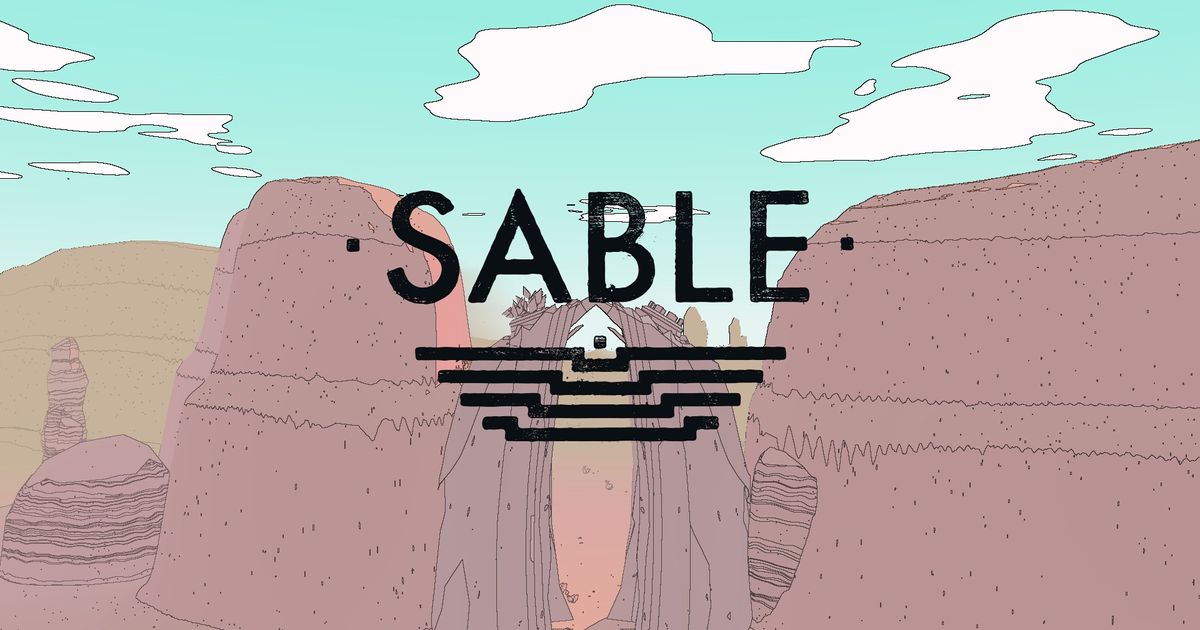We all reach that point in our lives where a question needs asking: who do I want to be? Everyone’s got their own ideas, our “best laid plans” as some would term it, but actually finding that answer? It’s never a one-size-fits-all situation, conclusions are shaped by our individual experiences. Perhaps that’s why Sable doesn’t rush you to decide. Marking Shedwork's debut game, Sable presents a coming-of-age tale with distinctive visual flair. Focusing purely on exploration, it’s quite a unique experience.
Table of Contents
Read More: Lake Review: A Deeply Relatable Tale About Coming Home
Badge Of Honour
Our journey begins at Ibex Camp, home to our titular character’s tribe, the Gliders. Having reached a certain age, Sable sets out on her “Gilding”, a rite of passage taking her across this strange world, accompanied only by her new hoverbike, Simoon, who you can later customise for improved performance. Though we’re initially advised on where to go first, Sable avoids giving players a main storyline. Her primary goal is obtaining a mask, determining which path Sable will walk in life, but you’ll decide what to undertake and where to visit. There’s no pressure or gentle plot persuasion.
However, Masks aren’t obtained outright. To earn them, you need to gain three badges of the same type and trade them in. Machinist badges are earned by (unsurprisingly) helping Machinists, members of a solitary order who devote their lives to machines. Merchants will offer you goods like new parts for Simoon and one Merchant even lets you buy badges directly. Beetle badges are gained through beetle-related quests, while Entertainer badges are usually awarded for sillier tasks, like playing hide-and-seek with kids.
Once you’ve chosen a quest, that sets a marker on your compass to follow, often guiding you to new locations. Cycling across the desert takes time, though once you’ve visited somewhere, you can fast travel back later, though its not all driving. Sable is rather athletic and, though limited by a stamina gauge, she’ll take a hands-on approach to exploration, climbing across strange ruins and gliding across gaps in platforming-esque sequences. Often, you’ll spot treasure chests which provide cuts (currency) and new equipment, so it pays to be thorough.
Home Is Where The Ibex Is
Now, Quests don’t always hold a pre-determined outcome, either, offering you choice. For example, before leaving Ibex Camp, Sable’s after a calibrator to build her bike, but a girl called Saima’s taken it from the original location, demanding three beetles in exchange. You can catch them, sure, but an NPC tells you where Saima’s hideout is, letting you nab it. Another involves investigating who sabotaged the city of Eccria’s power supply and naming a suspect. Sable then builds an evidence portfolio and names potential suspects, though if your argument’s not convincing, this can fail.
There’s significant freedom in how you proceed, which can leave Sable feeling directionless at times and sadly, several decisions lack consequence as a result. Once you’ve obtained a Mask, you can head back to Ibex and finish this adventure, or you can keep exploring, taking further quests and earning even more masks.
Unfortunately, these endings fall flat. Considering this journey’s about her rite of passage, they never truly expand upon the weight of Sable’s decision, feeling somewhat shallow. However, what’s important here is the journey. Often subtle in its storytelling approach, Sable’s a slow burner initially but after spending more time with the game, it became a refreshing change of pace, and you do feel Sable grow across this journey.
Line By Line
While I respect the narrative approach, being similarly vague about explaining core gameplay mechanics wasn't great. Sable runs through the basic controls and bike mechanics, but at no point does it tell you "Hey. Now you've visited this location, you can fast travel back later via the map," or "did you know you can increase Sable's stamina?" Putting that aside, once you’ve beaten Sable, reloading your save returns you to before that point of no return, letting players carry on exploring and find other masks, which provide additional bonuses.
Of course, I can’t discuss this without going into Sable’s visuals. Utilising a line-art aesthetic, it takes inspiration from Studio Ghibli - with Shedwork previously citing Nausicaa of the Valley of the Wind and Princess Mononoke as inspiration – proving highly stylised and somewhat minimalist. It’s a unique approach that gives sable a distinctive identity, backed up by a pleasant soundtrack.
Regrettably, this wasn’t always perfect and proved slightly jarring at points. During my playthrough, the line art began moving in strange ways and backgrounds felt slightly off, leaving me unsure if that was a glitch or intentional. That wasn’t helped by the odd performance stutters, which was never terrible, but I noticed the odd framerate dip.
Verdict
There’s plenty to like about Sable but ultimately, this isn’t for everyone. Due to performance issues, weak endings, lack of direction and a failure to explain key elements, several flaws hold it back. However, by offering strong narrative freedom, enjoyable exploration without combat, and a unique visual approach, Sable still felt quite refreshing in some regards. Ultimately, it’s an entertaining debut by Shedwork and if you can look past those flaws, it comes recommended.
3/5
Review copy provided by publisher
Reviewed on PC using these specs, played with an Xbox Series controller.





